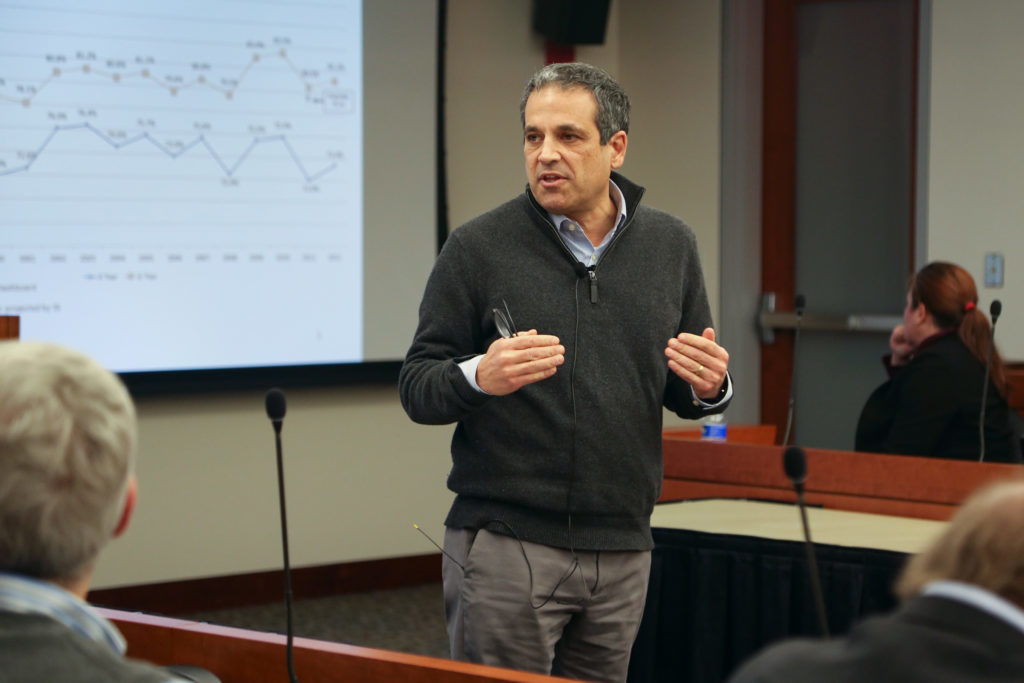GW’s six-year graduation rate dropped by 3 percentage points last year amid a University-wide effort to encourage students to stay enrolled.
The graduation rate, a measure of student satisfaction and academic success, fell to 80.5 percent in 2017 – about one percentage point higher than initially projected, Provost Forrest Maltzman told the Faculty Senate this month. Experts said a one-year decline is not necessarily significant because graduate rates often fluctuate from year to year, but if the decrease becomes a trend for several years, officials should change retention strategies.
Maltzman told the Faculty Senate that officials anticipate the six-year graduation rate will rise to 81.2 percent next year for the group of students that enrolled at GW in 2012. He said officials are removing barriers that can prevent students from graduating and improving internal student transfer processes and academic coaching for students who need extra support.
This year’s decline comes after two years of increases brought the rate from 79.5 to 83.5 percent. Maltzman said last year officials anticipated that the graduation rate would be below 80 percent in 2017, because six-year graduation rates are heavily determined by the first two years of the enrollment period.
GW’s rate is high compared to the national average of 66 percent at four-year nonprofit private universities, according to the National Center for Education Statistics. But Maltzman said GW can still improve and the entire University community should recognize that improving graduating rates is their responsibility.
He said the effort faculty and academic advisers made to work individually with students through graduation helped the rate exceed initial expectations in 2017. GW’s average graduation rate over the last four years – a measure used by major university ranking systems – is one of the highest in University history, he added.
“We made it a mission to go through every single kid, and we had a number of students where we did what we could do in trying to get these students through,” Maltzman told the Faculty Senate.
Officials have sharpened their focus on retention – ensuring students who come to GW stay enrolled – in recent years, hiring an official dedicated to the subject in 2016. In January, the University announced the creation of the Office of Enrollment and the Student Experience to start in July, which is designed to manage a student’s entire experience at GW from the admissions process to graduation.
This academic year, officials have talked extensively about the need to improve student satisfaction and have said graduation rates would be an important future indicator of the success of that effort.
“Enhancing the quality of the student experience by creating an environment where everyone feels welcome, supported and challenged is critical to enhance an institution’s graduation rate,” Maltzman said in an email.
Erin Doran, an assistant professor at Iowa State University School of Education, said it would take between three to five years for the University to see actual results from its new retention efforts because students who were freshmen when the drive began have not yet graduated.
“Figuring out what strategies these students need, developing the programs and hiring the personnel to deliver the support to students takes time,” Doran said.
She added that the perception of a downward trend in graduation rates could negatively affect how many applications the University receives because the U.S. News and World Report rankings take into account indicators like the six-year graduation rate.
The University’s peer schools have similar six-year graduation rates. The University of Pittsburgh’s graduation rate is around 81 percent last year, according to its website. New York University’s six-year graduation rate reached 85 percent last year.
CJ Libassi, a policy analyst of postsecondary-education at the Center for American Progress – a progressive think tank, said universities often change the type of students they enroll to improve graduation rates, rather than changing practices to support students already on campus.
Libassi said institutions are tempted to enroll elite, well-off students with a high chance of graduating to boost their statistics rather than taking chances on equally qualified students from first-generation or lower-income backgrounds who may be seen as more of a risk of not completing their college education.
“I would rather see a rich university like GW take a chance on high-achieving, low-income students,” he said. “Students who meet their criteria but who may face other challenges and nontraditional students.”
Mei Ling Wilson contributed reporting.





